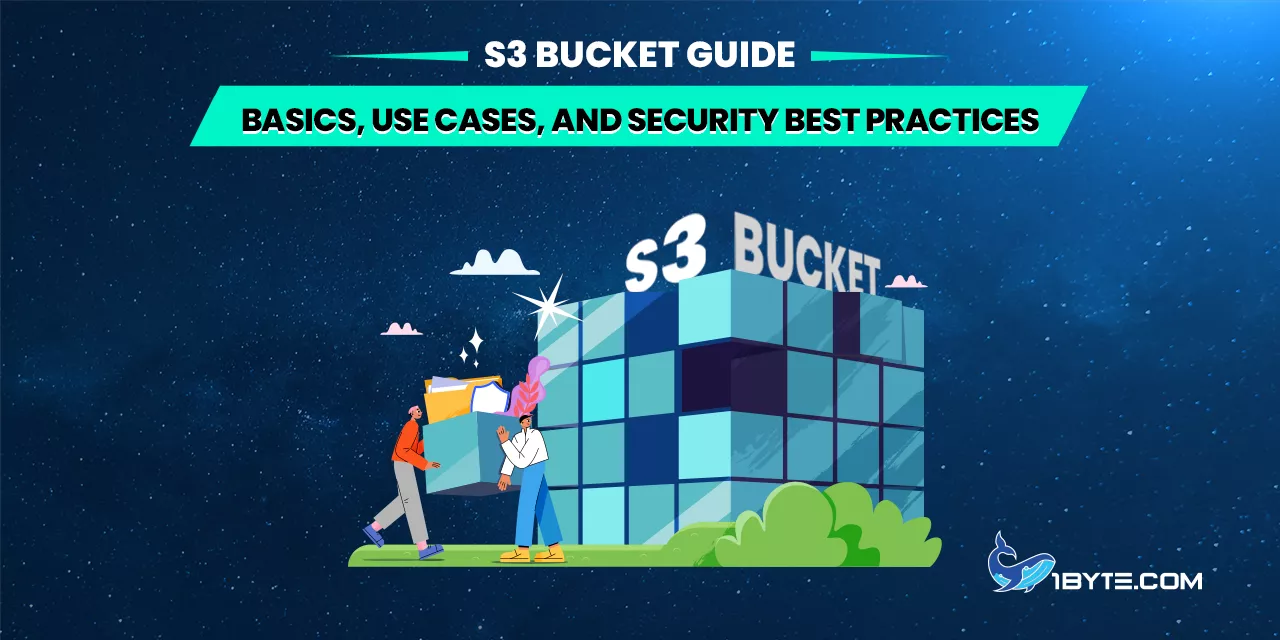The use of cloud storage is significant in the current digital age. It could be a startup that stores pictures or a big company that stores decades of information. The necessity to have reliable and scalable storage is increasing rapidly. One of the most widely used solutions is the S3 bucket, offered by Amazon Web Services (AWS).
An S3 bucket lets users store and organize files in the cloud, with high durability and global access. It’s simple to use, yet powerful enough to support everything from static websites to big data applications. Because of its flexibility and reliability, the S3 bucket has become a core part of how companies manage their data online.
This guide from 1Byte explains what an S3 bucket is, how it works, and why it matters. It covers common use cases, updated stats, and security best practices to help beginners understand how to use S3 buckets safely and effectively.

An Overview of Amazon S3 Bucket
Launched in 2006, Amazon S3 was one of AWS’s first services and helped pioneer modern cloud storage. AWS reports that S3 holds over 350 trillion objects (an exabyte-scale dataset). For example, developers and companies can use S3 to store and retrieve any amount of data from anywhere. In S3, data is organized as objects (files) inside containers called buckets. Each S3 bucket has a unique name across all AWS accounts and is located in one AWS Region. For newcomers, an S3 bucket is simply a container for files in the cloud.
- Durability: Amazon S3 is constructed to be highly reliable. It replicates several copies of every object in various facilities. This provides a 99.999999999% (eleven nines) life. This practically implies that files are virtually never lost even when hardware fails.
- Scalability: S3 can scale indefinitely. It can store exabytes of data and handle massive workloads. AWS reports that S3 processes over 100 million requests per second on average. The service automatically scales with demand, so there is no need to set limits in advance.
- Storage Classes: AWS has several S3 storage classes depending on the requirements. An example is the Standard class which is used in frequently accessed data, Infrequent Access (IA) which is used in less frequently accessed data and Glacier classes which are used in long-term archives. You can configure lifecycle policies to cause S3 to transition objects to lower-cost classes as time elapses. AWS observes that S3 offers a variety of storage classes at the most optimal price-performance with any workload to save on costs.
- Versioning: You can enable versioning on an S3 bucket to keep multiple versions of each object. This lets you restore an older version of a file if it is accidentally deleted or overwritten.
- Access Control: By default, S3 buckets and all objects in them are private. They can be accessed by authorized users or roles only. The access is controlled with the help of AWS IAM policies, bucket policies, and ACLs. This granular control ensures that only permitted entities can read or write data in your S3 bucket.
Amazon S3 buckets run on AWS’s secure global infrastructure. Objects and metadata can be stored in any number of objects in each bucket. AWS scales S3 to automatically grow with the addition of data. As an illustration, the bucket increases in size as you add additional files, and you do not have to do anything to increase the size of the bucket. Due to this design, one does not have to worry about the lack of space. AWS keeps a copy of your data in various places to ensure that it is secure. This provides S3 with a very high durability.
Now your data is in S3 buckets, and you control how it is managed. You can, as an example, set up lifecycle rules to automatically move old files to a lower-cost storage class as they age. Buckets and objects are defaulted to be private and only explicit permissions are allowed to access them. Access controls are provided through IAM roles or bucket policies. This allows S3 to be used in various applications such as basic backups and even to run sophisticated applications. AWS also offers a free level (5GB of S3 storage each month during one year) that allows beginners to start off free.

Common Use Cases
Organizations rely on S3 buckets for many purposes. It can be applied in media storage, as well as in big data analysis. S3 is flexible to different workloads. The examples are common and they include:
- Data Lakes and Analytics: A large number of companies create data lakes on S3 that are large in size to store both structured and unstructured data. According to AWS, thousands of customers (such as GE, Bristol-Myers Squibb and others) use S3 data lakes due to the fact that S3 is secure, durable and highly scalable. As an example, Sysco centralized its data into an S3 data lake (with S3 Glacier used to store older data) and saved more than 40 percent on storage expenses. This data can then be queried by the analysts through such tools as Amazon Athena or AWS Glue.
- Backup and Archiving: S3 (particularly using Glacier classes) is perfect in backups and long term archives. It is far less expensive than conventional storage of data that is seldom accessed. As an example, Ancestry (a genealogy company) has a huge photo archive in S3 Glacier and can recover terabytes of photos within hours, rather than days. On the same note, BBC transferred its 100-year multimedia archive to S3 Glacier Instant Retrieval to save on costs and yet have access to old information within a short time.
- Static Website Hosting: You can configure an S3 bucket to host a static website (serving HTML, CSS, and JavaScript files). Visitors can access your content via HTTP endpoints. To do this, the Block Public Access setting on that bucket must be disabled. Static websites on S3 are fully managed and will scale automatically with traffic.
- Media and Content: S3 is a popular storage of media such as videos, images, and logs. It is used together with Amazon CloudFront (CDN) to distribute content worldwide. As an illustration, NASCAR has moved all its video, audio and image library to S3, which has allowed the company to scale and process media much more quickly. GE Healthcare has been storing medical imaging data of more than 500,000 devices using S3, and it has been counting on the reliability of S3 to ensure that the important data is not lost.
- Machine Learning and AI: AI and machine learning projects are frequently based on S3. ML models require big datasets and S3 can store them at a low cost. AWS points out that S3 already has more than 350 trillion objects, which provide customers with an enormous data pool. As an example, Grendene (a footwear company) created an AI-based virtual assistant based on an S3 data lake. Simply put, any task that requires big data (such as training ML models) can be scaled and performed with the help of S3.
In addition to these, S3 is integrated with other AWS services. As an example, S3 can be used to invoke AWS Lambda functions when new objects are created. This allows serverless event driven workflows. Amazon Athena can also be used to query S3 data, or it can be loaded into Amazon Redshift and analyzed. These integrations render S3 a core element in most of the cloud-based solutions.

Other Considerations and Advanced Features
Amazon S3 also provides special needs. As an example, Cross-Region Replication (CRR) may be used to automatically replicate objects in one bucket to a bucket in another AWS Region. This offers disaster recovery and redundancy in the event of failure in one region. Object Lock can also be implemented by S3 where an object cannot be deleted or overwritten within a set period of time. These characteristics are beneficial in compliance and data protection needs.
S3 also has advanced lifecycle configuration. In addition to changing storage classes, objects can be configured to expire automatically after some period of time. As an example, objects can be set to be deleted after 90 days. This assists in automatically cleaning up ancient data. S3 pricing is determined in terms of storage used, data transfer and number of requests. It is also usually cost-effective, although make sure to choose the appropriate storage class depending on your access patterns. Rarely accessed data can be stored in Glacier or Deep Archive which can reduce costs significantly. AWS offers a cost calculator to estimate costs. To test S3, it is simple to take advantage of the AWS Free Tier that provides 5 GB of standard S3 storage at no charge every month, so new AWS accounts receive 60 GB of free storage in the first year.
It is prudent to keep an eye on your consumption as your information increases. You may use AWS Cost Explorer or establish AWS Budgets to notify about expenditure. Monitoring will assist you to prevent unpleasant surprises as you can track the evolution of storage use and requests rates.
Security Best Practices for S3 Buckets
Securing S3 buckets is essential. Buckets are not locked down and data in the cloud can be exposed. By default, S3 buckets start private. Actually, AWS has recently increased the tightening of defaults: new buckets are automatically blocked to public access and ACLs are turned off. This is attributable to the fact that most high-profile data breaches happened when buckets were left unintentionally open. In order to prevent these issues, pay close attention to the AWS security recommendations.
- Block Public Access: S3 Block Public Access should always be set on unless you have a specific requirement of a public bucket. This environment supersedes any policy or ACL that could permit access by the public. AWS has now defaulted on this with new buckets. It should be disabled only when you are sure that you require a public bucket (to host a static site). As a rule, do not make buckets public.
- Encryption: Encrypt your data at rest and in transit. AWS encrypts all new S3 objects by default (SSE-S3 with AES-256). You can also choose AWS KMS for stronger control. Additionally, always use HTTPS (TLS 1.2 or higher) when accessing S3. This ensures data is encrypted both on disk and while moving over the network.
- Least Privilege: Grant only the permissions needed to each user or role. When writing IAM or bucket policies, avoid broad grants. Do not use wildcard principals or actions unless absolutely necessary. For example, do not set “Principal”: “*” in a policy if only a few accounts need access. Use IAM roles for applications or services (like EC2 or Lambda) so they receive temporary credentials. This limits the impact if credentials are compromised.
- Versioning: Enable bucket versioning to guard against accidental deletions or overwrites. With versioning on, older versions of an object are kept whenever it is changed or deleted. This lets you recover any object back to a previous state if needed.
- Monitoring and Logging: Turn on logging and monitoring to detect any issues. Enable AWS CloudTrail logging for S3 to record all API calls (who accessed or changed what). Also enable S3 Server Access Logging to record every request to your buckets. You can then use AWS Config rules or Amazon GuardDuty to flag any unusual access patterns. Regularly review these logs and alerts to make sure nothing unexpected is happening.
- Bucket Naming and Lifecycle: Select bucket names that are not easy to guess in case you need privacy. Remember that S3 bucket names are global: avoid deleting a bucket if you plan to reuse its name later, because once deleted, anyone could claim that name. You can empty the contents of a bucket and retain it instead of throwing it away. Also, it is worth putting lifecycle policies in place to automatically expire or archive old data, which is cost-effective and risk-reducing.
These practices will significantly mitigate the exposure of data. The AWS now implements numerous best practices by default (including default encryption and blocking public access), but you still have to set buckets up properly. Think of an S3 bucket like a secure database: keep it private by default and only open it up to specific users or services as needed. Audits should be conducted regularly, as well as such tools as AWS Trusted Advisor and AWS Config, which can be used to make sure that your buckets are not compromised over time.
Conclusion
Amazon S3 buckets are a foundational cloud storage tool that offers virtually unlimited, durable storage. AWS continues to lead the cloud market: for example, reports show AWS has an 85% enterprise adoption rate, implying S3 is widely used in industry. AWS reports that S3 holds over 350 trillion objects and handles more than 100 million requests per second, demonstrating S3’s massive scale. AWS continues to innovate on S3: for example, at AWS re:Invent 2023 they announced the S3 Express One Zone storage class, designed for ultra-fast, single-Availability Zone data access.
For beginners, the key is that S3 buckets are easy to use and very flexible. It is possible to begin with the creation of a bucket and upload files using the AWS Console, AWS CLI, or SDKs. Do not forget about security best practices: buckets should remain private, data should be encrypted, and access should be monitored. With these steps, users can confidently use S3 buckets to store anything from simple backups to large datasets.
In summary, S3 buckets combine simplicity with enterprise-grade features. They allow developers to work on application or analytics development, and AWS takes the burden of durability and scaling. By understanding the basics, exploring common use cases, and applying the security guidelines above, anyone can make the most of S3 bucket storage in the cloud.

